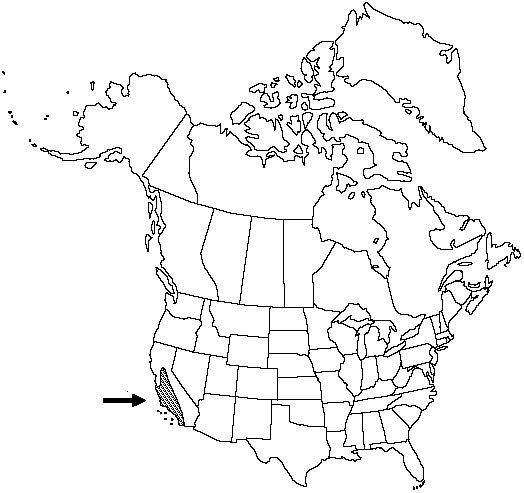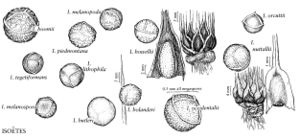Difference between revisions of "Isoëtes orcuttii"
Fern Bull. 8: 13. 1900.
FNA>Volume Importer |
imported>Volume Importer |
||
| (7 intermediate revisions by 2 users not shown) | |||
| Line 12: | Line 12: | ||
|name=Isoëtes nuttallii var. orcuttii | |name=Isoëtes nuttallii var. orcuttii | ||
|authority=(A. A. Eaton) Clute | |authority=(A. A. Eaton) Clute | ||
| + | |rank=variety | ||
}} | }} | ||
|hierarchy=Isoëtaceae;Isoëtes;Isoëtes orcuttii | |hierarchy=Isoëtaceae;Isoëtes;Isoëtes orcuttii | ||
| Line 20: | Line 21: | ||
}}<!-- | }}<!-- | ||
| − | --><span class="statement" id="st- | + | --><span class="statement" id="st-undefined" data-properties=""><b>Plants </b>becoming terrestrial. <b>Rootstock</b> nearly globose 2(–3)-lobed. <b>Leaves</b> deciduous, bright green, pale toward base, less than 8 cm, gradually tapering to tip, often surrounded at base by several black scales to ca. 5 mm, spirally arranged, pliant, gradually tapering to tip. <b>Velum</b> covering entire sporangium. <b>Sporangium</b> wall unpigmented. <b>Megaspores</b> white to gray, lustrous, 200–380 μm diam., ± smooth to obscurely tuberculate; girdle obscure. <b>Microspores</b> brown in mass, 20–30 μm, smooth to papillose. <b>2n</b> = 22.</span><!-- |
-->{{Treatment/Body | -->{{Treatment/Body | ||
| + | |phenology=Spores mature in spring. | ||
|habitat=Vernal pools | |habitat=Vernal pools | ||
|elevation=mostly 0–1500 m | |elevation=mostly 0–1500 m | ||
|distribution=Calif.;Mexico in Baja California. | |distribution=Calif.;Mexico in Baja California. | ||
| − | |discussion=<p>Isoëtes orcuttii, a vernal pool endemic, may be difficult to distinguish from I. nuttallii, which occurs in a wider range of habitats. Plants of I. orcuttii are generally smaller than those of I. nuttallii, which has longer, thicker, less flexible leaves and larger megaspores.</p> | + | |discussion=<p><i>Isoëtes orcuttii</i>, a vernal pool endemic, may be difficult to distinguish from <i>I. nuttallii</i>, which occurs in a wider range of habitats. Plants of <i>I. orcuttii</i> are generally smaller than those of <i>I. nuttallii</i>, which has longer, thicker, less flexible leaves and larger megaspores.</p> |
|tables= | |tables= | ||
|references= | |references= | ||
| Line 35: | Line 37: | ||
-->{{#Taxon: | -->{{#Taxon: | ||
name=Isoëtes orcuttii | name=Isoëtes orcuttii | ||
| − | |||
|authority=A. A. Eaton | |authority=A. A. Eaton | ||
|rank=species | |rank=species | ||
| Line 42: | Line 43: | ||
|basionyms= | |basionyms= | ||
|family=Isoëtaceae | |family=Isoëtaceae | ||
| + | |phenology=Spores mature in spring. | ||
|habitat=Vernal pools | |habitat=Vernal pools | ||
|elevation=mostly 0–1500 m | |elevation=mostly 0–1500 m | ||
| Line 49: | Line 51: | ||
|publication year=1900 | |publication year=1900 | ||
|special status= | |special status= | ||
| − | |source xml=https:// | + | |source xml=https://bitbucket.org/aafc-mbb/fna-data-curation/src/2e0870ddd59836b60bcf96646a41e87ea5a5943a/coarse_grained_fna_xml/V2/V2_430.xml |
|genus=Isoëtes | |genus=Isoëtes | ||
|species=Isoëtes orcuttii | |species=Isoëtes orcuttii | ||
| − | |||
| − | |||
| − | |||
| − | |||
| − | |||
| − | |||
| − | |||
| − | |||
| − | |||
| − | |||
| − | |||
| − | |||
| − | |||
| − | |||
| − | |||
| − | |||
| − | |||
| − | |||
| − | |||
| − | |||
| − | |||
| − | |||
}}<!-- | }}<!-- | ||
-->[[Category:Treatment]][[Category:Isoëtes]] | -->[[Category:Treatment]][[Category:Isoëtes]] | ||
Latest revision as of 20:23, 5 November 2020
Plants becoming terrestrial. Rootstock nearly globose 2(–3)-lobed. Leaves deciduous, bright green, pale toward base, less than 8 cm, gradually tapering to tip, often surrounded at base by several black scales to ca. 5 mm, spirally arranged, pliant, gradually tapering to tip. Velum covering entire sporangium. Sporangium wall unpigmented. Megaspores white to gray, lustrous, 200–380 μm diam., ± smooth to obscurely tuberculate; girdle obscure. Microspores brown in mass, 20–30 μm, smooth to papillose. 2n = 22.
Phenology: Spores mature in spring.
Habitat: Vernal pools
Elevation: mostly 0–1500 m
Distribution

Calif., Mexico in Baja California.
Discussion
Isoëtes orcuttii, a vernal pool endemic, may be difficult to distinguish from I. nuttallii, which occurs in a wider range of habitats. Plants of I. orcuttii are generally smaller than those of I. nuttallii, which has longer, thicker, less flexible leaves and larger megaspores.
Selected References
None.
